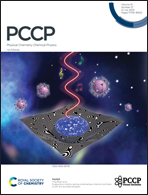The interplay between size, shape, and surface segregation in high-entropy nanoalloys†
Abstract
The respective influences of particle shape and size on the energetic stability of five-component multimetallic nanoparticles have been computationally investigated for AlCuFeCrNi and AuCuPdNiCo mixtures at equiconcentration. Using available embedded-atom model potentials, exchange Monte Carlo simulations possibly assisted with systematic quenching, we explore tools to approach ideal phase equilibrium in such high-entropy nanoalloys. In particular, we show how deviations to ideal solid solution behaviors can be characterized using percolation analyses, and how the contribution of alloying fluctuations at finite temperature can be inferred to evaluate the entropy of mixing in such nonideal cases. An approximation to the entropy of mixing based on pair correlations only is also found to capture the behavior of the thermodynamical mixing entropy quite well, and can be used as an order parameter of mixing. While the AlCuFeCrNi mixture appears to mix reasonably well in all cases considered, cobalt and nickel segregate significantly in AuCuPdNiCo nanoparticles, deviating strongly from ideal random mixtures. A simple Gaussian regression model applied to a coarse distribution of concentrations is found to correctly predict conditions for optimising the mixing thermodynamical properties of the miscible AlCuFeCrNi nanoparticle.



 Please wait while we load your content...
Please wait while we load your content...